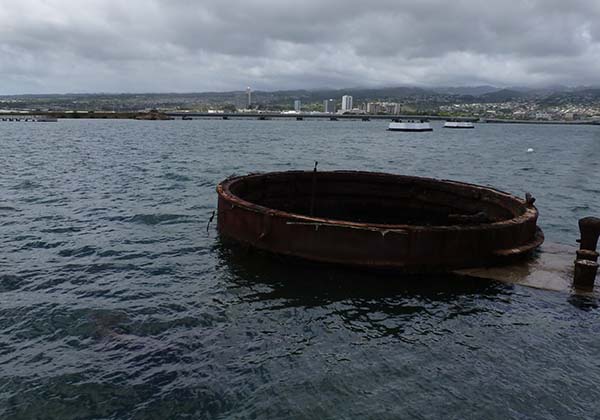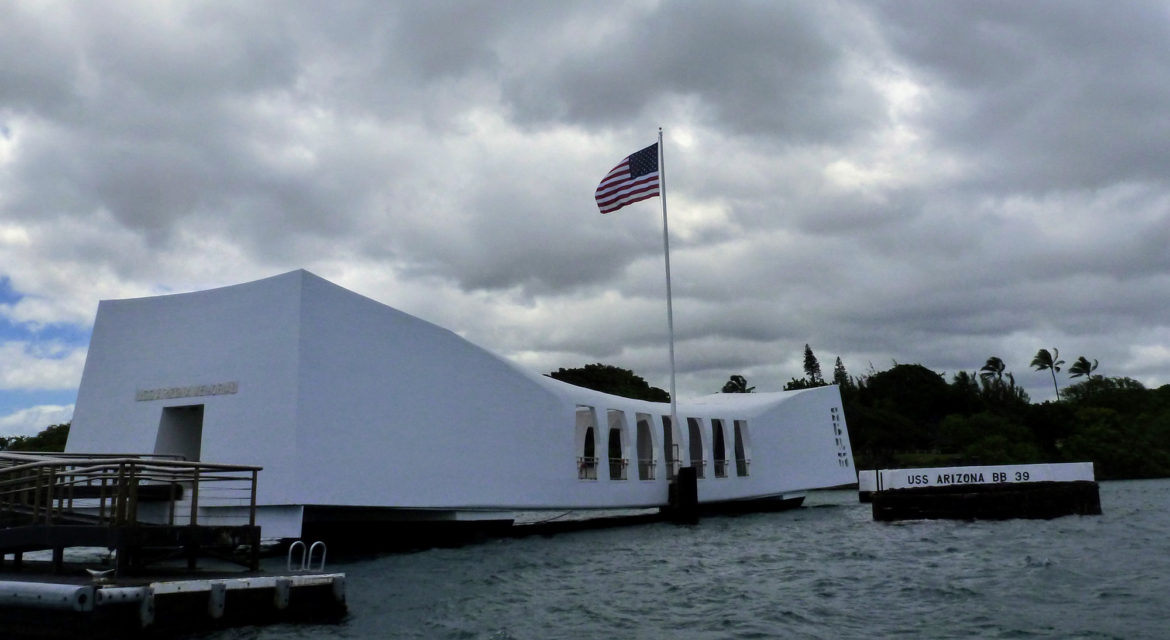 A Japanese attack against the naval base at Pearl Harbor in Honolulu, Hawaii that took place in 1941 changed the course of world history. It led to the United States’ formal entry into World War II, which eventually led to the surrender of the Japanese aboard the battleship U.S.S. Missouri in 1945. The legacy of these incidents along with countless others that occurred before and after the attack and surrender can be experienced in numerous ways at the Pearl Harbor National Memorial, which preserves and interprets the stories, people and sites of the Pacific War. The Memorial is an incredible example of how such events can be honored while also creating a lasting economic and cultural influence.
A Japanese attack against the naval base at Pearl Harbor in Honolulu, Hawaii that took place in 1941 changed the course of world history. It led to the United States’ formal entry into World War II, which eventually led to the surrender of the Japanese aboard the battleship U.S.S. Missouri in 1945. The legacy of these incidents along with countless others that occurred before and after the attack and surrender can be experienced in numerous ways at the Pearl Harbor National Memorial, which preserves and interprets the stories, people and sites of the Pacific War. The Memorial is an incredible example of how such events can be honored while also creating a lasting economic and cultural influence.

From Infamy to Monument
The December 7, 1941, attack on Pearl Harbor in Oah’u compelled the United States’ entry into World War II. The attack killed more than 2,300 military and civilian personnel and still serves as the final resting place of hundreds of crewmembers of the USS Arizona and USS Utah. The Pearl Harbor National Memorial interprets and preserves sites and artifacts from this attack as well as the subsequent history and sacrifices that were made during the Pacific War.
 The Pearl Harbor National Memorial is located in Joint Base Pearl Harbor-Hickam, on the island of Oahu in the State of Hawaii. It was designated as a national historic landmark in 1964, but the historical and cultural significance of the area has changed over time. The USS Arizona Memorial was constructed over the hull of the sunken USS Arizona and dedicated by the Pacific War Memorial Commission in 1962. Both the USS Arizona and USS Utah shipwrecks are designated national historic landmarks located in Pearl Harbor.
The Pearl Harbor National Memorial is located in Joint Base Pearl Harbor-Hickam, on the island of Oahu in the State of Hawaii. It was designated as a national historic landmark in 1964, but the historical and cultural significance of the area has changed over time. The USS Arizona Memorial was constructed over the hull of the sunken USS Arizona and dedicated by the Pacific War Memorial Commission in 1962. Both the USS Arizona and USS Utah shipwrecks are designated national historic landmarks located in Pearl Harbor.
The complex also features two exhibit galleries, outdoor exhibits, an audio tour, a theater, and a bookstore. From the main entrance of the Memorial, visitors are able to access other Pearl Harbor Historic Sites, such as the USS Bowfin Submarine Museum and Park, the Battleship Missouri Memorial, as well as the Pacific Aviation Museum. All of these places house various pieces of history as well as displays that allow viewers to better understand the context of the events that took place throughout World War II.
On December 5, 2008, an executive order established the USS Arizona Memorial and other Pearl Harbor sites as part of the World War II Valor in the Pacific National Monument, Pearl Harbor. It was an event that underscores how the experiences visitors to the Pearl Harbor National Memorial continue to change and evolve in powerful ways.

Experiencing History in Multiple Ways
 History is displayed in countless ways all across all of the sites at the Memorial, whether it’s actual pieces of history, displays that recount what happened at or near the area, or monuments dedicated to a particular person or event. This variety of experiences allows visitors to understand the significance of the space in numerous ways. They are many ways for them to gather context of this history that they can directly engage with.
History is displayed in countless ways all across all of the sites at the Memorial, whether it’s actual pieces of history, displays that recount what happened at or near the area, or monuments dedicated to a particular person or event. This variety of experiences allows visitors to understand the significance of the space in numerous ways. They are many ways for them to gather context of this history that they can directly engage with.
The USS Arizona Memorial and visitor center (now referred to as the Pearl Harbor Visitor Center) straddles the sunken hull of the battleship without touching it. Accessible only by boat, the memorial consists of an entry, assembly room, and shrine. Visitors can see the Arizona barbette sticking out of the water as well as oil leaking from the sunken battleship, which has been referred to as “the tears of the Arizona.”
The Battleship Missouri Memorial has become of one of the most popular attractions at the site since the ship played such as active part in the history of World War II. Japan’s unconditional surrender was accepted aboard the Missouri, and the “Mighty Mo” now provides visitors with an interactive experience that allows them to look back through time. Guided tours provide special access to other areas of the ship. The “Surrender Deck” has become one of the most popular features of the entire site.
 The USS Bowfin Submarine Museum and Park allows visitors to board the vessel which survived nine war patrols and learn what life was like for the crew. Visitors can also experience the outdoor exhibits in a four-acre park, a museum devoted to the history of the U.S. submarine force, and a memorial honoring the American submarines and their crews lost during the war.
The USS Bowfin Submarine Museum and Park allows visitors to board the vessel which survived nine war patrols and learn what life was like for the crew. Visitors can also experience the outdoor exhibits in a four-acre park, a museum devoted to the history of the U.S. submarine force, and a memorial honoring the American submarines and their crews lost during the war.
The Pacific Aviation Museum at Pearl Harbor features two former World War II seaplane hangars that survived the attack in 1941, and they hold a collection of aircraft as well as a diorama depicting aviation in the Pacific Theater. Guided tours allow visitors to see Hangar 37 in addition to Hangar 79, where vintage and modern aircraft are on display, as well as scars of the actual attack.
All of these experiences honor and celebrate the legacy of the history and people associated with Pearl Harbor, and that celebration has enabled powerful cultural and economic opportunities for the site and region.

The Cultural and Economic Impact of a Monument
 While the ships and historical displays showcase the history of the area in a powerful way, there are countless memorials dedicated to the people who lost their lives at Pearl Harbor and in the war all across the site. The Waterfront Memorial features monuments to each of the 52 U.S. submarines and more than 3,500 American submariners lost during World War II. The Lone Sailor statue has a base that contains steel from the USS Arizona. These displays provide an important cultural context of what it means for such culture to be properly celebrated.
While the ships and historical displays showcase the history of the area in a powerful way, there are countless memorials dedicated to the people who lost their lives at Pearl Harbor and in the war all across the site. The Waterfront Memorial features monuments to each of the 52 U.S. submarines and more than 3,500 American submariners lost during World War II. The Lone Sailor statue has a base that contains steel from the USS Arizona. These displays provide an important cultural context of what it means for such culture to be properly celebrated.
That power has enabled the appearance of the Pearl Harbor National Memorial in so many different magazines and tourist materials, although residents can take part in the many events that take place at the memorial throughout the year. By providing tourists with such a powerful attraction, the site pulls in visitors from across the world to create a real economic impact that has direct and indirect impacts.
In terms of a direct impact, the museum gift shop and restaurant are unique in their offering and their authentic 1940s ambiance. Both feature unique items that can only be purchased at the location. Additionally, tickets and supplementary tours provide a powerful economic driver for the site while donations are easily accepted. Large donations may be earmarked for specific projects.
 The indirect economic impact of the Pearl Harbor National Memorial can be seen in terms of how a visit to the site is included in so many different packages that take visitors to the Memorial along with other locations throughout the island. The list of authorized commercial transportation providers for the Pearl Harbor National Memorial illustrates the extent of this economic impact on businesses throughout the area.
The indirect economic impact of the Pearl Harbor National Memorial can be seen in terms of how a visit to the site is included in so many different packages that take visitors to the Memorial along with other locations throughout the island. The list of authorized commercial transportation providers for the Pearl Harbor National Memorial illustrates the extent of this economic impact on businesses throughout the area.
This cultural and economic impact of the Memorial is significant, but that impact is just part of the legacy it has come to represent for Oah’u, for Hawaii, and for the United States.

Creating and Enabling a Legacy
 Few sites have the historical significance that Pearl Harbor does, but it takes more than history to enable a legacy. By creating so many different unique experiences and preserving the history of the area in such a powerful way, the Pearl Harbor National Memorial has been able to attract visitors from across the world to celebrate this history while creating an indelible impact on the culture and economy of the island, state and country.
Few sites have the historical significance that Pearl Harbor does, but it takes more than history to enable a legacy. By creating so many different unique experiences and preserving the history of the area in such a powerful way, the Pearl Harbor National Memorial has been able to attract visitors from across the world to celebrate this history while creating an indelible impact on the culture and economy of the island, state and country.

